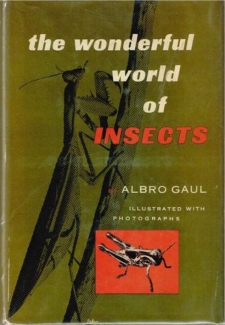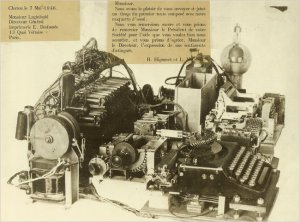 It is likely you have not read the 1953 edition of “The Wonderful World of Insects” by Albro Tilton Gaul. That’s OK. To be honest, I haven’t read it either. However, I do have a copy and I know that it is a very important book … not so much because it is about insects. “The Wonderful World of Insects” is important because it is the first book ever produced with phototypesetting.
It is likely you have not read the 1953 edition of “The Wonderful World of Insects” by Albro Tilton Gaul. That’s OK. To be honest, I haven’t read it either. However, I do have a copy and I know that it is a very important book … not so much because it is about insects. “The Wonderful World of Insects” is important because it is the first book ever produced with phototypesetting.
Prior to 1953, almost everything being printed used the casting method known as “hot type.” The mechanized production of molten metal type characters was first created by Gutenberg in the 1440s and his technique thrived for over 400 years. The system was revolutionized by Mergenthaler’s Linotype machine in the 1880s.
Beginning in the 1940s, with the invention of “cold type” by Louis Moyroud and his fellow inventor Rene Higonnet, the typographic process was again being revolutionized. Moyroud and Higonnet’s breakthrough was significant because type creation went from being a mechanical to an electronic process. But more fundamentally, the two French engineers had initiated technologies that would later lead to a transformation of the graphic arts from analog to digital technology. This evolution is not complete. It continues developing to this day.
Louis Marius Moyroud was born on February 16, 1914 in Moirains, Isère, France and was the only child of Marius and Ann Marie Vial Moyroud. Louis never knew his father, who died when he was an infant. His mother worked in a textile factory.

As a student, Louis was outstanding. He received government support to study engineering at one of the best institutions in France, École Nationale Supérieure d’Arts et Métiers and he graduated in from there in 1936. Upon graduation, he served in the French army as a second lieutenant and was promoted to first lieutenant in 1939.
Louis’s work as an inventor began after 1941, when a subsidiary of ITT Corporation in Lyon called LMT Laboratories hired him. International Telephone and Telegraph was by this time a global corporation that owned both telephone services infrastructure and manufacturing operations that produced telephone equipment.
In the early 1940s, Louis was working with Rene Alphonse Higonnet when they observed the traditional process of hot metal typesetting in a French printing plant. Based upon some scientific breakthroughs associated with light, optics and photography, Moyroud and Higgonet believed that an alternative to the casting of molten metal typesetting could be developed.
As with many breakthrough technologies, there were many people trying to displace hot metal typesetting with a more advanced system. Moyroud and Higonnet were the first to build a functioning solution that was made into a commercial product. Much of the pressure to find a viable photographic typesetting system was being driven by the replacement of the letterpress printing method by offset lithography.

According to Louis’s son Patrick, “My dad always said they thought it was insane [the Linotype process]. They saw the possibility of making the process electronic, replacing the metal with photography. So they started cobbling together typewriters, electronic relays, a photographic disc.”
Moyroud and Higonnet worked throughout the war years on their project and first demonstrated their invention in September 1946 in Lyon. Their first functioning photocomposing machine used a typewriter, a strobe light and a series of lenses to project characters from a spinning disk onto photographic paper. The typeset copy could then be used to make printing plates. Moyroud and Higonnet called their machine the Lumitype.

With the post-World War II technology revolution underway, Louis and Rene moved to the United States to pursue the commercialization of their concept. They approached Vannevar Bush, president of MIT and President Roosevelt’s top technology adviser, with their prototype. Bush put them in touch with William Garth, President of Lithomat Corporation, a Cambridge, MA manufacturer of presensitized offset duplicator plates.
Garth was convinced that a successful phototypesetting system would stimulate the growth and expansion of offset printing and drive sales of his Lithomat plates. He formed the Graphic Arts Research Foundation to raise financial resources for the development and marketing of Moyroud and Higonnet’s invention. Encouraged by the possibility of dramatic cost reductions in the print production process, Garth attracted support from major newspaper publishers, book printers and traditional typesetting services.
 After several years of development work, significant support for the project came in. Garth spent over $1 million to create a prototype phototypesetter. He also changed the name of his firm to Photon, Inc. The prototype device was called Petunia and it was used to set the type of the “Wonderful World of Insects” in 1953. In 1957, Moyroud and Higonnet were granted a patent for their invention and tens of thousands of phototypesetting machines were sold.
After several years of development work, significant support for the project came in. Garth spent over $1 million to create a prototype phototypesetter. He also changed the name of his firm to Photon, Inc. The prototype device was called Petunia and it was used to set the type of the “Wonderful World of Insects” in 1953. In 1957, Moyroud and Higonnet were granted a patent for their invention and tens of thousands of phototypesetting machines were sold.
For more than 30 years, this method of producing type was dominant for printing, publishing and advertising copy. Mechanical artwork was produced by “paste up” artists around the world for reproduction on offset lithographic printing presses. Hot metal type and letterpress printing rapidly receded into the background, although some Linotype-generation systems remained in use for specialty work and that continues today.
In 1985 (two years after the death of Higonnet), Louis Moyroud and Rene Higonnet were inducted into the National Inventors Hall of Fame in Alexandria, Va. Ironically, 1985 is also the year of the advent of desktop publishing, a technology that would— within a few years—completely displace phototypesetting as a method of producing type for print. This fact shows that phototypesetting was a transitory development along the path of the digital transformation of the graphic arts.
Louis Moyroud continued his work on phototypesetting systems into the 1980s and his career as an inventor extended beyond the displacement of his most important contribution. He retired to Delray Beach, Florida where he later died in June 2010 at the age of 96.
Frank Romano, who worked with Moyroud as the advertising manager of Photon in 1969, wrote the following tribute to Louis, “He had a wonderful sense of humor and an unassuming demeanor. He had collected most of the early phototypesetters and donated them to the Museum of Printing in North Andover. Petunia is on display.
“John Crosfield, Rudolf Hell, Benny Landa, and Dan Gelbart are among the inventors who moved the printing industry to new levels, but the era of automation began with Louis and Rene. Louis is now gone and revolution he began is now ended. But other revolutions continue.”
